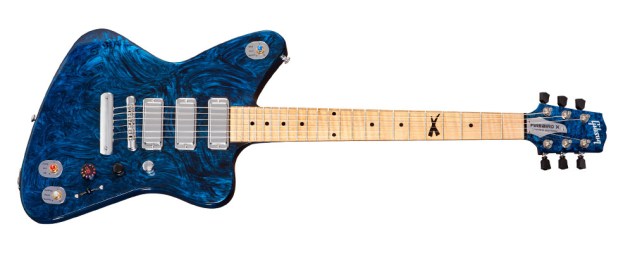
Way back in 2007 Gibson rolled out its first “robot” guitar, featuring motorized tuners that could quickly tune up the instrument without much player intervention—and even switch between common tunings on the fly. Now, Gibson is on the verge of launching the Firebird X, the latest in its series of high tech instruments. And the guiltar-maker has thrown everything and the kitchen sink into this one: three mini-humbuckers, a bridge piezo pickup, Gibson’s own hex pickup (with individual output for each string), fourth-generation robot tuning technology, and plus bevy of built-in effects that enable users to switch between radically different tones without having to sprint all the way across an arena stage to jump on a floorboard. Oh, and there’e Bluetooth for communicating with a custom pedalboard and—wait for it—apps. Gibson will be running it own app store where users can potentially swap out Gibson’s own “Pure-Analog” audio processing engine with something totally new.
“Innovation has always been the driving force at Gibson, and the Firebird X is nothing short of groundbreaking,” said Gibson chairman and CEO Henry Juszkiewicz, in a statement.. “The Gibson Firebird X is truly the most technologically-advanced guitar ever conceived.”
OK, first for the guitarists in the audience: the Firebird has always looked cool, but has never been the most ergonomic guitar on the planet, and the three mini-humbuckers and switching combinations always seemed to be a solution looking for a problem rather than a system that delivered reliable, classic, or even usable tones. But Firebirds definitely have their fans, and Gibson has tried to address some issues: the Firebird X body is just over six pounds or swamp ash, and the guitar has an asymmetrical C-shape neck with a non-slip back finish and a polished curly maple with ebony inlays. Gibson has beefed up the mini-humbuckers with a “studio quality” pre-amp and access to both single and double-coil modes. The Firebird X also features a bridge piezo pickup, similar to pickup systems used in acoustic guitars, and Gibson claims the Firebird X’s acoustic palette is almost indistinguishable from the electric output on its J45 acoustic guitars. (Of course, anyone who’s plugged in a stock J45 knows that isn’t necessarily great—they can be wonderful guitars, but their pickups often quack like constipated ducks—apologies, Mr. Beck.) The Firebird X also sports fourth-generation robot tuners, with immediate access to automatic tuning as well as tuning changes—they’re faster and lighter than previous generations, and can retune multiple strings simultaneously.

The top of the guitar features “tog-pots” built into rotatable toggle shafts to enable players to switch between built-in effects tones on the guitar: Gibson promises these are all pro-level tons and effects, including multiple mod, delay, and reverb effects, and even a 10-second looper. There’s actually a boundary mic built into the Firebird X’s tailpiece that helps the onboard electronics manage DSP processing in real time—there are also six sliders tucked into the top bass bout of the guitar for effect parameter adjustment in real time.
Gibson is also rolling out some accessories with the Firebird X, including a case the company claims can enable the instrument to survive a fall from a “six-foot building.” (Because, yes, it’s common to tour the lands of dwarves and hobbits!). There’s also a Bluetooth-enabled pedalboard and rocker pedal—no wires!—and the guitar comes with software to enable users to design their own patch sets and transfer them to the guitar. It also ships with Abelton Live Lite 8 and Guitar Rig 4. The footpedals and guitars all use the same batteries, but Gibson says the guitar only runs about two hours on a battery: swapping is fast (and even camcorder batteries can be used as replacements), but plenty of pros play shows longer than two hours. Gibson also plans to launch its own app store, where users can download new Gibson-approves apps to enhance the guitar…although so far, nothing is up and running.
The Firebird X will launch on September 30 for a suggested price of $5,570—and Gibson plans to only make 1,800 of them in an effort to turn them into “instant collectibles.” It also means there probably won’t be much incentive for developers to make their own apps, with an audience of 1,800.


